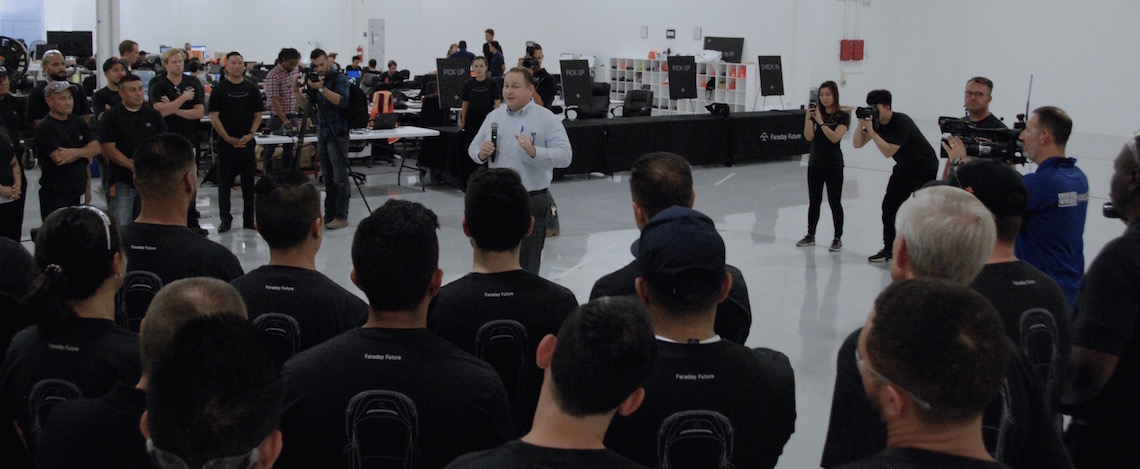
Hanford City Manager Darrel Pyle welcomes the first employees hired to work at Faraday Future’s electric car manufacturing plant in Hanford. He noted this is the first full-scale car making facility in the Valley. Photo by David Castellon
Written by
A couple of weeks after assembling its first pre-production car, Faraday Future offered the media a peek at its new manufacturing plant in Hanford.
But that look didn’t include the manufacturing floor of the million-square-foot former tire plant the startup electric carmaker is leasing on the northern edge of Hanford.
Instead, the press was shown about 10 percent of the facility — the research and testing area for new cars coming out of the manufacturing side.
“What we’re walking through is the gamma phase, that’s essentially for the testing and internal use of the vehicle — obviously, a relatively small portion of the facility, And all around us is being built up for the ultimate production,” separated by temporary walls, said John Lehn, the head of Faraday’s Hanford government affairs office.
Still, the inside of the building was a stark contrast to the dark, dingy building about 400 Faraday employees from the company’s Gardena headquarters came to inspect and begin sprucing up back in August 2017, shortly after the fledgling company announced it would scrap plans to build its first-ever car plant in Nevada and instead lease the Hanford building.
The renovated area reporters got to see Tuesday was freshly painted — white top to bottom — which included fresh, white epoxy floors and new LED lighting throughout the building.
But the invitation wasn’t so much to show off the four-year-old startup’s renovated digs as much as it was for company officials to introduce some of the first nearly 100 employees hired to work at the new Hanford facility and announce its ready to hire a lot more.
“What is going on today is we are celebrating the initial stages of what is to be an ‘F wave’ of hiring for the Hanford area,” which is planned to number by the first half of next year more than 1,000 people, most filling manufacturing and administrative jobs, said Matt Davis, a spokesman for Faraday.
Officials said several of the new employees are coming from other established carmakers, Honda, Ford and General Motors among them, as well as from other emerging electric vehicle makers, Tesla, Inc. and Fisker Automotive.
“People are coming, and we’re embracing them,” Davis said.
Company officials noted that when the dozens of employees present Tuesday were asked if grew up in the Central Valley, more than half raised their hands.
Among them was Lehn, the former president of the Kings County Economic Development Corp. and director of the county’s Job Training Office who worked with Faraday and Hanford officials to help the car company’s efforts to locate in the city. Earlier this year, he announced plans to retire from his two jobs but later accepted a job offer from Faraday.
“I can tell you, I spent 52 years of my life living within 40 miles of this building, and I never anticipated being in the auto industry here in the San Joaquin Valley,” said Hanford City Manager Darrel Pyle, who was asked to address the new employees and reporters.
He added that the new factory has garnered Hanford both national and international attention, to the point that a day prior he had a reporter from Beijing in his office to discuss the car company.
“You have not just put Hanford on the map, you have put us on the globe.”
Pyle also praised all the employees for taking the chance of working for a startup.
When asked if the company expects to be challenged hiring people in the Valley with the sorts of skills needed in a full-scale auto factory, an industry that has never existed here before, Vince Nguyen, Faraday’s human resources director said, “I think in canning and general assembly, the same skill sets will apply over,” so training local people from industries that exist here into car-manufacturing jobs shouldn’t be difficult.
“There are also special training courses that should get everyone up to speed quickly.
“On top of that, also, we have a great marketing team to announce in Hanford today that we are looking to hire additional team members,” said Nguyen, who added that the company is planning a job fair, possibly late this month, but details weren’t immediately available.
“The job fair will be a big deal. I think that’s going to attract a lot more technical talent that we need.”
Members of the press were restricted on what they could photograph in the research-and-development area, including new workers being trained in assembling an FF91, the high-end, all-electric sports utility vehicle that will be the company’s flagship model.
The assembly area still is being developed, though the first pre-production car was built on the line about two weeks ago, and more are in various stages of development, Davis said.
He added that plans are to have the manufacturing area — the largest part of the plant — finished and running before the end of this year.
And hopes are to have cars available for sale and delivery by March 30, 2019, Nguyen added.
Once that happens, Faraday plans to start selling them first in the Los Angeles and Bay Areas — the nation’s two most active electric vehicle markets — before expanding to other parts of the U.S.
As for how much the FF91 will set buyers back, automotive media reports have ranged from $150,000 to a report by a Chinese news source quoting company founder Jia Yueting as saying last year it would cost “less than 2 million Chinese Yuan,” equal to about $290,000 U.S.
“I think that’s speculation. I think there are gong to be different [FF91] models that we can actually choose from” with different prices, said Nguyen, who didn’t disclose what those prices might be.








